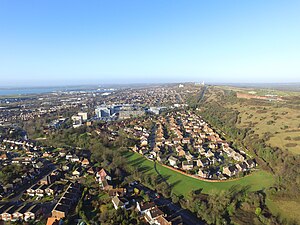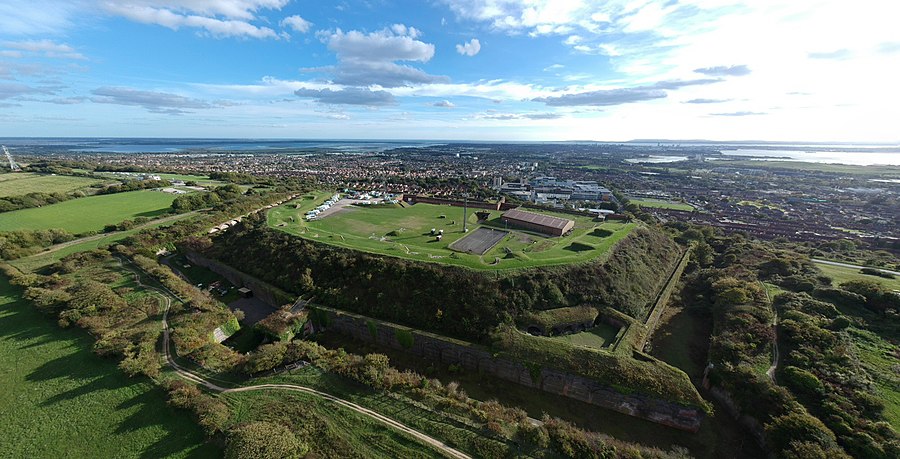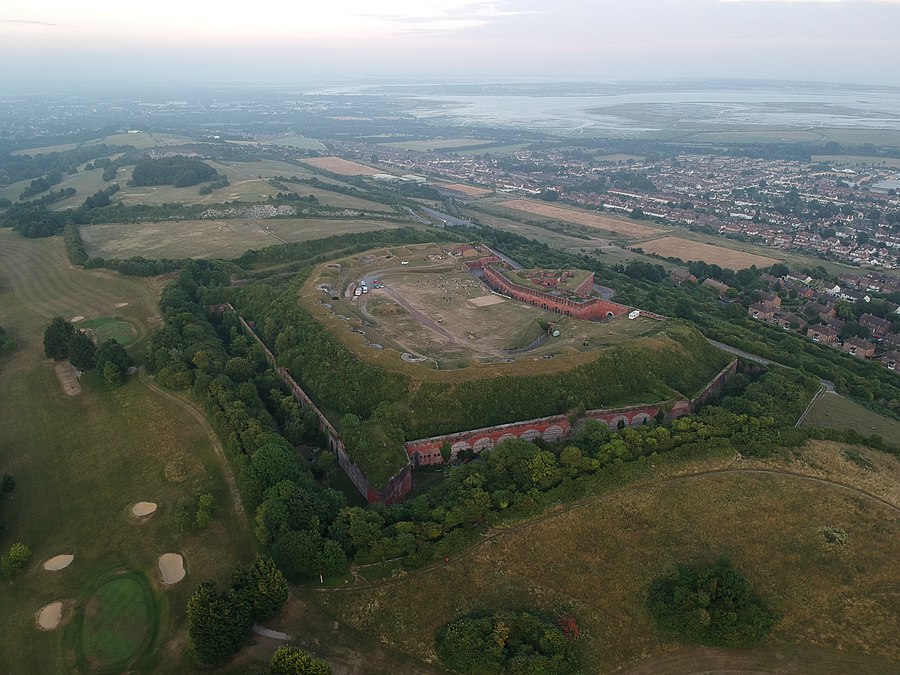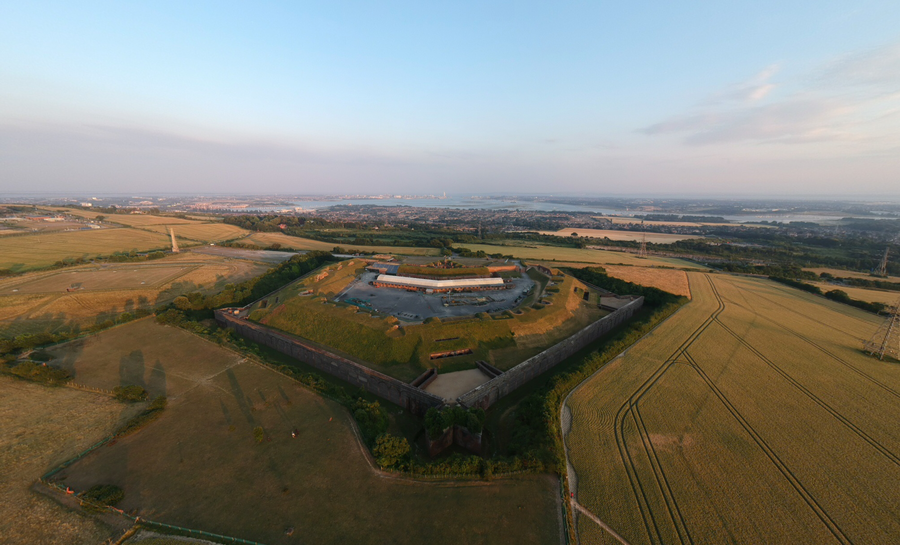Portsdown Hill
| Portsdown Hill | |
| Hampshire | |
|---|---|
 Portsdown Hill Area, Portsmouth North | |
| Summit: | 430 feet SU627069 50°51’30"N, 1°6’38"W |
Portsdown Hill or Ports Down is a long chalk ridge in the south of Hampshire, broadly marking a division between rural Hampshire to the north and the towns spreading our from Portsmouth. The highest point of the hill lies within Fort Southwick at 430 feet above sea level.
The ridge offers good views to the south over maritime Hampshire: to Portsmouth, the Solent, Hayling Island and Gosport, and the Isle of Wight beyond. The hill is on the mainland, just to the north of Ports Creek, which separates the mainland from Portsea Island, on which stands the City of Portsmouth, and the principal home of the Royal Navy. To the north of the ridge is the Forest of Bere, with the South Downs visible in the distance. Butser Hill can be seen on a clear day.
The hill is formed from an inlier of chalk which has been brought to the surface by an east–west upfold of the local strata known as the Portsdown Anticline.[1]
Southwick House is close by the north side of the hill, the HQ for U.S. General Dwight D. Eisenhower during the D-Day invasions; the generals prayed together before D-Day at Christ Church Portsdown, on the hill, which has a memorial window. The A3(M) motorway cuts through the east side of the hill while the original A3 climbs over the centre by the George Inn and Christ Church.
There are many stories about real and imagined tunnels in the hill.[2] The area contains active military research establishments, including one of the core sites of Dstl (known as Dstl Portsdown West) and sites run by QinetiQ.
History
During the early part of the Civil War Royalist forces from Portsmouth were involved in a number of skirmishes with Parliamentarians on the hill [3]
In the Victorian era the hill was home to a fair on Easter Mondays.[4]
Also in that period a series of forts was established, to defend Portsmouth against the threat of French invasion.
Portsdown Forts
The forts on Portsdown Hill were built as a result of the Royal Commission on the Defence of the United Kingdom in 1859, as part of a series of fortifications (nicknamed 'Palmerston Forts') built to defend Portsmouth and its dockyard (five mniles away) from a possible attack from inland, as the development of rifled gun barrels made it possible for an invading army to land elsewhere, circle around to the top of the hill and bombard the city from there, rendering the existing Hilsea Lines at the bottom of the ridge useless.
A series of six forts were planned along the six miles of the ridge. From west to east they are:
The line was finished off at the eastern end with Crookhorn Redoubt and Farlington Redoubt. The main threat was perceived to be from Napoleon III of France, but this receded soon after the forts' completion. Due to this they became known as "Palmerston's Folly" but, though never needed for their original purpose, were useful anti-aircraft gun emplacements during Second World War.
Fort Fareham is now a small industrial estate.[5] The remains of the Fort are Grade II listed.[6] Fort Wallington has been largely demolished to make way for an industrial estate. What remains is now a Grade II listed structure.[7]
Fort Nelson has been extensively restored as an artillery museum run by the Royal Armouries. It is a Grade I Listed Building.[8]
Fort Southwick was for many years an Admiralty Research Establishment, sold in 2003 for housing.[9] It is also now a Grade I Listed Building.[10][11]
Fort Widley is owned by Portsmouth council, hosting a stable and various community rooms. It is Grade II* listed.[12] Fort Purbrook' houses an activity centre which offers such acticvities as archery, rifle shooting and indoor rock-climbing. It is also Grade II* listed.[13][14]
Guarding Fort Purbrook, the Crookhorn redoubt suffered from subsidence, and was demolished by 1876. The Farlington redoubt had only the ditches and gun positions dug, and was finally demolished in the 1970s.[15] The tunnel between Crookhorn and Purbrook has been rediscovered.[16]
Fort WidleyConservation
Part of the hill, about 124 acres on the south side of the hill, has been designated a Site of Special Scientific Interest, in view of its chalk grassland habitat. Grazing ceased in the early 1950s, and consequently the site was gradually invaded by scrub, mostly hawthorn, dogwood, and wild privet. An intensive restoration programme funded by the Countryside Commission and Portsmouth City Council was initiated in 1995; large areas of scrub have now been cleared by machine, and flowers and grasses allowed to regenerate naturally. Scrub re-encroachment is controlled by cattle and horses which graze overwinter.
Most of the southern flank of the ridge is designated as access land under the Countryside and Rights of Way Act 2000 and thereby freely available for the public to enjoy on foot.
Several species of butterfly became extinct owing to the loss of habitat to scrub, notably the Adonis blue, silver-studded blue, dingy skipper, and dark green fritillary. Others such as the chalkhill blue and small blue were at the brink of extinction, but are now flourishing again. Indeed, the hill has now probably the largest metapopulation of the small blue in the United Kingdom.
Outside links
- Palmerston Forts Society
- Victorian Forts data sheets:
- Portsdown Tunnels
- Christ Church Portsdown
- Subterranea Britannica:
- The Royal Armouries at Fort Nelson
- Conservation Management and Volunteering on Portsdown Hill
References
- ↑ British Geological Survey 1998 Fareham England and Wales sheet 316 solid and drift geology. 1:50,000 (Keyworth, Nottingham: BGS)
- ↑ Portsdown Tunnels - Researching the sites of Portsdown
- ↑ Webb, John (1977). The Siege of Portsmouth in the Civil War. Portsmouth City Council. p. 14. ISBN 0-901559-33-4.
- ↑ Penny, Legg (2010). Folklore of Hampshire. The History Press. p. 18. ISBN 978-0-7524-5179-4.
- ↑ "Fort Fareham, Hampshire". http://www.subterraneanhistory.co.uk/2009/03/fort-fareham-hampshire.html.
- ↑ National Heritage List 1094240: Fort Fareham (Grade II listing)
- ↑ National Heritage List 1094233: Fort Wallington (Grade II listing)
- ↑ National Heritage List 1350616: Fort Nelson (Grade I listing)
- ↑ "Fort Southwick NATO Communications Centre – Subterranea Britannica". http://www.subbrit.org.uk/rsg/sites/f/fort_southwick_comcen/index.html.
- ↑ National Heritage List 1167213: Fort Southwick (Grade I listing)
- ↑ National Heritage List 1104368: Fort Southwick (Grade I listing)
- ↑ National Heritage List 1387128: Fort Widley (Grade II* listing)
- ↑ National Heritage List 1092134: Fort Purbrook (Grade II* listing)
- ↑ National Heritage List 1387127: Fort Purbrook (Grade II* listing)
- ↑ "Portsdown Tunnels - legends & mysteries - Fort Purbrook - page 1". http://www.portsdown-tunnels.org.uk/legends_mysteries/palmerston_forts_p1.html.
- ↑ "Portsdown Tunnels - legends & mysteries - Fort Purbrook - page 2". http://www.portsdown-tunnels.org.uk/legends_mysteries/palmerston_forts_p2.html.



